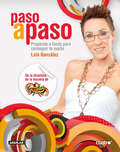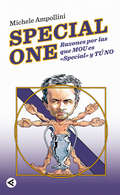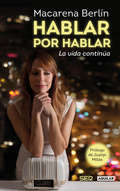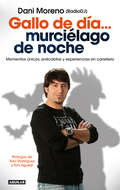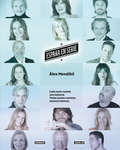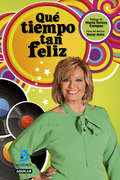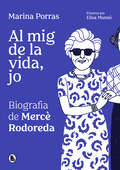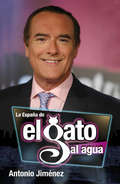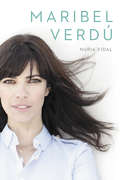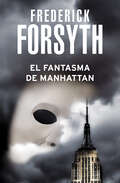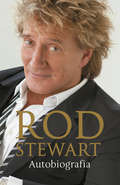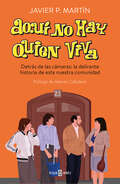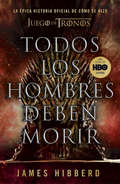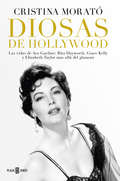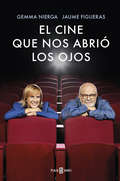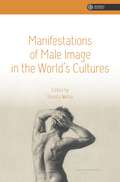- Table View
- List View
Paso a paso (Fama): Prepárate a fondo para conseguir tu sueño
by González, Lola¿Te gustaría conquistar tu sueño y no sabes por dónde empezar? ¿Fantaseas a menudo con la idea de triunfar sobre los escenarios? ¿Eres fan del programa Fama ¡a bailar! y quisieras seguir el ejemplo de alguno de los concursantes más queridos? Si harías lo que fuera por conseguir tu sueño, descubre que el secreto para alcanzarlo se esconde en tu interior. Abre bien los ojos y aprende paso a paso: - a rentabilizar tus dudas y a conocer tus limitaciones. - a cuidar tu imagen para que sea perfecta en cualquier entrevista o casting. - a valorar la importancia del trabajo y a interiorizar que la pasión y la entrega son los valores necesarios para conseguir el éxito. - a ser autodisciplinado, a escuchar, a preguntar y a trabajar en equipo. Lola González, la directora de la escuela de Fama ¡a bailar!, el programa de superación personal y de baile de más audiencia de la televisión, te ofrece en Paso a paso los mejores consejos y las anécdotas más divertidas de la escuela, y todo lo que ha aprendido como profesional de la danza y como profesora en los últimos años. Un libro divertido en el que encontrarás las herramientas necesarias para hacer realidad tu sueño.
Special One: Razones por las que Mou es Special y tú no
by Michelle AmpolliniRazones por las que Mou es Special y tú no... Disfruta con las anécdotas más divertidas y desconocidas del entrenador más especial del mundo. Lo nunca dicho sobre el Special one: «Special one está muy bien». Woody Allen «Soy un humilde pastor en la viña del Special one». Benedicto XVI «El Santo Grial es una copa, así que dejad de buscarla porque la habrá ganado el Special one». Dan Brown ¿Te has preguntado alguna vez por qué Mou es «Special» y tú no? Descubre todo lo que se podría decir del entrenador de moda, de sus entrevistas más polémicas y de su actitud ante la vida en Special one, un libro desternillante e irónico que recuerda a las famosas frases de Chuck Norris o a los tweets de Arturo Pérez-Reverte y con el que no podrás parar de reír.
Hablar por hablar. La vida continúa
by Macarena BerlínHistorias de superación, de lucha... Historias de madrugada. «En este libro, el tercero que se escribe sobre el programa de radio Hablar por hablar, he recogido algunas de las llamadas que he atendido en los primeros cinco años que llevo al frente del mismo. Historias que quizá no hayan ocupado las primeras páginas de los periódicos, pero que han ilustrado las madrugadas de este programa social al servicio del oyente de la radio. Llamadas que bien pudo recibir Gemma Nierga, porque en algunos aspectos poco hemos cambiado; y llamadas que hace dos décadas eran impensables. Imaginación para ponerles voz a los personajes de la vida y empatía para sentir cada una de sus palabras es lo único que se necesita para acercarse al corazón de los protagonistas de Hablar por hablar».Macarena Berlín Macarena Berlín, directora y presentadora de Hablar por hablar en la Cadena SER, ofrece a los lectores las vocesde los protagonistas de este espacio radiofónico transcritas desde el corazón, desde la pura emoción. Historias de superación, de valentía, experiencias diversas que se van hilvanando con el objetivo de encontrar la comprensión al otro lado del teléfono, las palabras de aliento, de apoyo o el simple desahogo. Una obra emotiva repleta de realidad que atraviesa el alma y revela lo mejor de uno mismo. Hablar por Hablar es el espacio de radio hecho por y para los oyentes, que se emite en la Cadena SER. Lleva casi veinticinco años en antena y se ha convertido en un clásico de las madrugadas, con la audiencia más alta de la radio, en su franja horaria. Cada noche la realidad más cercana recupera sus derechos y los oyentes llaman a nuestro teléfono para compartir sus historias, sus inquietudes... de una forma natural y distendida, planteando debates y cuestionando todos los aspectos de la vida: desde los más cotidianos hasta los más insólitos, tocando la actualidad, pasando de lo entrañable a lo increíble, de lo más divertido a lo más triste. Reseña:«Este libro insólito es, entre otras cosas, el certificado de que lo que escucharon sucedió. Pero también de que lo soñaron. Es el certificado de que soñamos lo que nos sucede, o al revés, y de que la noche es una dimensión paralela de la que solo tomamos conciencia cuando se nos aparece, como en un eclipse, en medio del día. Este libro es un grumo de oscuridad en medio de la luz, pero también un fogonazo en medio de las tinieblas. Este libro es el revés de la vida. Al leerlo, se convierte en su derecho».Juanjo Millás
Gallo de día murciélago de noche: Momentos únicos, anécdotas y experiencias en carretera
by Toni Aguilar Dani Moreno Xavi RodríguezEl mágico mundo de la radio ¿Quién no se sentiría orgulloso de levantarse un lunes sabiendo que lo que hace puede cambiar la vida de alguien para mejor? Dani Moreno, radioDJ de Máxima FM, pagaría por ir a trabajar cada día a la radio porque no puede vivir sin ella. En Gallo de día# murciélago de noche encontraremos sus veinte años de carrera como locutor y como DJ. Lo que le ha sucedido delante y detrás de un micrófono, en el escenario, en el estudio, durante las entrevistas a personajes famosos, en el backstage, en la producción, en la publicidad, en las cabinas, en los hoteles, durante los viajes, en los programas en directo, de clubbing. Anécdotas y experiencias diurnas y nocturnas, los oyentes, los mejores DJ del mundo y el reconocimiento: el premio Ondas. Un libro divertido repleto de momentos radiofónicos estelares y sesiones de infarto que surge de la pasión por la música, lleno de positivismo y energía, en el que el Gallo Máximo te cuenta cómo se hizo realidadsu sueño. Una experiencia de lectura interactiva en la que los lectores más marchosos pueden disfrutar -a través de códigos QR- de vídeos en exclusiva, videoclips y de los momentos memorables de Dani Moreno.
España en serie. Cada serie cuenta una historia y todas juntas cuentan nuestra historia
by Álex MendíbilUn viaje a través del tiempo, la realidad y la ficción. Todas las series cuentan una historia y todas juntas cuentan nuestra historia. España en serie parte de un trabajo documental minucioso elaborado por Canal + durante un año y medio de producción, con más de 90 entrevistas a algunas de las actrices, actores, guionistas, directores y productores de televisión más importantes de las últimas décadas. Este libro reconstruye y amplía ese valioso material, que acapara los principales acontecimientos históricos y sociales de la ficción televisiva española, por y para los amantes de las series. La historia de España se cuenta a lo largo de estas páginas desde una nueva óptica, con un peculiar orden cronológico que empieza en Hispania para llegar a las series del futuro como Plutón BRB Nero, permitiendo así un análisis horizontal de cada época. Críticas de televisión, testimonios de los artistas, de los profesionales y un poderoso material gráfico completan un estudio pormenorizado y exquisito. De forma simultánea se alza en España en serie una visión sociológica ya que la interpretación de los acontecimientos varía en función de la década y de la situación del país. ¿Cómo se veía la España de los Reyes Católicos en los años del destape o de la movida y cómo se ve ahora con Isabel? ¿Cómo eran los personajes de las series de la Transición y cómo los ve Cuéntame? Gracias al oficio y a la prosa de Álex Mendíbil la lectura de este libro se convierte en una gratificante experiencia, en un recuerdo de los mejores momentos vividos enfrente del televisor. Un recorrido por más de 50 años de historia de la televisión y 23 siglos de historia de España, un viaje a través del tiempo, la realidad y la ficción. Los protagonistas han dicho... «La que llega a todos: esa es la serie buena». Antonio Resines «La teleme llevó a dedicarme a ser actriz». Carmen Machi «La ficción llegó para quedarse y se va a quedar. El público demanda cosas con las que se sienta identificado». Emilio Aragón «Hay momentos de éxtasis en la tele». Javier Cámara «Tenemos necesidad de conocer nuestra propia Historia». Josefina Molina «El espectador, finalmente, lo que tiene que hacer es conmoverse con lo que aparece por la tele». Juan Echanove «Somos la última generación que empezamos en blanco y negro. Y cuando desaparezcamos, ya sólo quedarán los archivos». José Sancho «Yo un día abrí El País y ponía que los tres personajes más populares de España eran Letizia Ortiz, Fernando Alonso y Fernando Tejero y a mí aquello me horrorizó». Fernando Tejero «España en serie cuenta la historia de un país a través de una nueva óptica y con un peculiar orden cronológico». El Siglo de Europa Reseñas: «Sobre emociones e historia, aunque contemporánea, gira el volumen de España en serie, escrito por Álex Mendíbil con motivo del programa del mismo título emitido recientemente por Canal + y en el que se recoge el archivo de la memoria para contar la historia de España en series». Diario de Noticias
Qué tiempo tan feliz
by María Teresa Campos LuqueQué tiempo tan feliz nos transporta de manera mágica a un pasado que sigue muy presente en nuestras vidas. Las luces y las sombras de artistas, películas, espacios televisivos y canciones que forman parte de la cultura popular de España. ¿Sabías que los «Quince años» del Dúo Dinámico hizo que más de un padre se llevara las manos a la cabeza en los sesenta?, ¿que Los Pecos tuvieron que hacer la mili para dar ejemplo y que Manolo Escobar era conocido no sólo por sus canciones, sino por su forma de besar en el cine? ¿Sabías que María Jiménez fregaba los suelos de las casas en las que le dejaban cantar, que Fórmula V tuvo problemas con la censura, que Arévalo empezó como Bombero torero o que Bustamante es un maniático del orden? Qué tiempo tan feliz reúne para ti los mejores momentos, los más entrañables, divertidos, curiosos, vividos en directo junto a María Teresa Campos, el director del programa, Yusan Acha, el equipo y los invitados, y da cuenta de anécdotas sorprendentes que se revelaron en este espacio por primera vez. Gracias a un estilo ameno rebosante de guiños a un lugar común que nos acerca a pesar de la edad y de las experiencias vividas, Qué tiempo tan feliz nos transporta de manera mágica a un pasado que sigue muy presente en nuestras vidas. Las luces y las sombras de artistas, películas, espacios televisivos y canciones que forman parte de la cultura popular de España y que componen un fresco en el que el ayer y el hoy conviven con naturalidad. La memoria de una época que evoca recuerdos agradables, un tiempo tan feliz. «Este libro bucea en los recuerdos, en la sentimentalidad de los momentos y de las personas que pertenecen a nuestras vidas, en las luces y las sombras de las trayectorias de éxito mientras se acerca al presente, a las generaciones que crecieron con ellos y a las nuevas que tienen interés en descubrir nuestra historia más reciente».María Teresa Campos
Al mig de la vida, jo
by Marina PorrasLa biografia sobre l'autora més influent de la literatura catalana des de la mirada fresca i revel·ladora de Marina Porras, periodista i crítica literària La vida de Mercè Rodoreda és la conquesta de la individualitat que es necessita per escriure. De nena va ser educada per ser una esposa convencional, de jove aspirava a ser una periodista del sistema i dues guerres la van fer créixer i descobrir de cop el món del segle XX. De l'estricta supervivència al descobriment de la solitud, Rodoreda va entendre que només se salvaria a través de l'escriptura si els seus llibres rescataven la memòria del seu temps. Marina Porras, periodista i crítica literària, explica en aquest retrat biogràfic la manera com es lliguen la vida i l'obra de l'escriptora més influent de la literatura catalana. La infantesa a la Barcelona d'abans de la guerra, la joventut a l'exili francès, la vida parisenca, l'esclat artístic a Ginebra i els anys finals a Romanyà.Una biografia fresca i directa amb il·lustracions de Elisa Munsó.
La España del gato al agua
by Antonio JiménezUn libro sobre el polémico programa de El gato al agua. La España de El gato al agua realiza desde una radiografía políticamente incorrecta de la sociedad española. Con un estilo incisivo y directo, alejado de los tópicos y los discursos imperantes, Antonio Jiménez traslada el carácter transgresor, ameno y polémico del programa al análisis de los temas que más preocupan a los españoles: la deriva económica, el ataque a la familia tradicional, las mentiras sobre el terrorismo, los intereses ocultos tras los escándalos de corrupción# Y para ello cuenta con la ayuda de sus colaboradores habituales (Carlos Dávila, Mario Conde, Juan Manuel de Prada, Eduardo García Serrano, Javier Nart, Antonio M. Carmona, Isabel Durán, Esther Jaén, Román Cendoya, Miguel Durán, Carmen Tomás, Alfonso Rojo, Cristina Alberdi, entre otros), que, sin pelos en la lengua, analizan con testimonios exclusivos todas las facetas dela actualidad española.
Maribel Verdú
by Nuria VidalUn libro sobre Maribel Verdú, una de las estrellas más internacionales de nuestro cine e icono generacional. Aunque resulte difícil de creer, Maribel Verdú ha cumplido veinticinco años en el cine. En este tiempo ha rodado más de sesenta películas a las órdenes de los directores más prestigiosos dentro y fuera de España, en papeles por los que ha recibido un sinfín de premios y que no dejan lugar a dudas sobre la talla de esta extraordinaria actriz, joven, guapa y protagonista de alguna de las secuencias más sensuales de la historia del cine español. Una mujer de su tiempo y con una personalidad arrolladora que trasciende la gran pantalla por su naturalidad, su simpatía desbordante, el compromiso sin límites con su trabajo y un entusiasmo que la lleva a colaborar con directores noveles y en películas de escaso presupuesto siempre que haya un papel que merezca la pena. Con el desenfado y la gracia que la caracterizan, nos habla sin reparos de éxitos y fracasos, de sus amigos, de las ciudades que ama o de las malas experiencias. Confiesa que le desagrada madrugar, que adora el orden y que le encanta salir a comer fuera porque no le gusta cocinar, o que su casa está llena de libros y pingüinos. Descubrimos a la Maribel más íntima, la que se muestra tal y como es, sin miedo a decir lo que piensa. En definitiva, una vida que resume la de toda una generación de mujeres que crecieron como ella en un país que empezaba a disfrutar de una libertad recién adquirida. Una mujer con mucho futuro por delante, gracias a esa buena estrella que nunca la abandona.
El fantasma de Manhattan
by Frederick ForsythEn El fantasma de Manhattan, Frederick Forsyth rescata a un personaje legendario de la literatura y el cine: el fantasma de la Ópera. Aprovechando la enigmática personalidad del atormentado ser que habita en los sótanos de la ópera de París, reelabora el mito del monstruo solitario, aislado del mundo a causa de su repulsiva fealdad.La novela empieza con los primeros años de Erik Muhlheirn, el "fantasma", en su lóbrego refugio del subsuelo parisino, donde, contra toda previsión, desarrolla una sensibilidad única para la música. Joven, incapaz de asumir su soledad, se enamora perdidamente de Christine, una de las cantantes. Movido por un deseo irreprimible, rapta a la muchacha. Pero sus planes, obviamente, están condenados al fracaso y Erik, prófugo de la justicia, debe abandonar Francia. Su huida lo lleva a Manhattan, donde lo aguardan el éxito y la fortuna. Sin embargo, deberá permanecer oculto tras la máscara, alimentando su obsesión, dedicando la vida entera a recuperar a su amada. Dando un giro imprevisto a su trayectoria novelística, Forsyth crea una obra conmovedora, impregnada del encanto de un tema clásico y el vigor narrativo de uno de los escritores más leídos de nuestro tiempo.
Rod Stewart: autobiografía
by Rod StewartRod Stewart nació en el norte de Londres en el seno de una familia de clase trabajadora, hijo de un fontanero escocés. A pesar de librarse por los pelos de carreras muy variadas, desde cavar tumbas hasta jugar en el fútbol profesional, lo que verdaderamente conquistó su corazón fue la música, y nunca se arrepintió.Rod empezó su carrera a principios de los años sesenta, tocando en los clubes de rhythm & blues de Londres, hasta que su particular voz ronca atrajo la atención del legendario vocalista Long John Baldry, que lo descubrió una noche durante una actuación en el andén del metro. Posteriormente, formó parte de grupos tan pioneros como los Hoochie Coochie Men, Steampacket y el Jeff Beck Group, que le allanaron el terreno para luego pasar cinco turbulentos años con los Faces, la banda de rock cuyos excesos con el alcohol, sus destrozos en las habitaciones de los hoteles y groupies los convirtieron en leyenda. Fue en ese periodo cuando sin embargo encontró un momento de paz para escribir «Maggie May», entre otras canciones, y emprender su carrera en solitario, que le ha llevado a vender unos doscientos millones de copias, a ser incluido dos veces en el Salón de la Fama del Rock and Roll y a tocar en el concierto más multitudinario de la historia. Como él dice, no está mal para un tío con la voz tan áspera.Por otra parte, nos describe su vida «no tan privada »: matrimonios, divorcios y aventuras amorosas con algunas de las mujeres más guapas del mundo ?chicas Bond, actrices y supermodelos, además de su escaramuza con un cáncer que amenazó con acabar con todo aquello.La vida de Rod es increíble y, en este libro, de forma emocionante y por primera vez, nos cuenta toda la historia, sin esconder los trapos sucios. Una juerga rocanrolera repleta de aventuras que en ocasiones resulta profundamente conmovedora; el extraordinario viaje de un tipo con una voz única, y una cabellera fenomenal.
Aquí no hay quien viva: Detrás de las cámaras: la delirante historia de esta nuestra comunidad
by Javier P. MartínEl libro definitivo de Aquí no hay quien viva solo podría resumirse en palabras del gran Juan Cuesta, presidente de esta nuestra comunidad: «¡Qué follón!» Alberto Caballero: Querían que no funcionara. Pensaron: «Que estos gilipollas emitan cinco, que están firmados por contrato, y que se vayan a la mierda». Loles León: «Ya lo decía el título: 'Aquí no hay quien viva'. Y efectivamente, ahí no había quien viviera».Fue la serie española más vista de la década de los 2000. Sus audiencias millonarias la convirtieron en la gallina de los huevos de oro. En cuestión de meses, los actores pasaron a tener las caras más conocidas del país. Dos décadas después sigue siendo un éxito en redes sociales y plataformas de streaming, gracias en parte a su capacidad para conquistar a cada nueva generación. Lo de Aquí no hay quien viva es único en la historia de la televisión española.Todo ello tiene aún más mérito cuando uno sabe cómo se hizo. Fue una apuesta en la que casi nadie creía, producida por el controvertido José Luis Moreno y creada y capitaneada por sus sobrinos, los por entonces inexpertos Alberto y Laura Caballero. La producción fue un caos diario en el que equipo técnico y reparto trabajaban a contrarreloj, y en jornadas interminables, para entregar a tiempo el episodio cada semana. Esta es la historia de un milagro televisivo, contada en palabras de los protagonistas. Este libro es la reconstrucción de tres años (¡solo tres años!) increíbles a través de más de medio centenar de entrevistas con las personas que los vivieron, de Fernando Tejero y Malena Alterio a los guionistas, pasando por técnicos y familiares.
Todos los hombres deben morir: La épica historia oficial de cómo se hizo Juego de tronos
by James HibberdLa épica historia oficial, avalada por HBO, de cómo se hizo la exitosa serie de televisión Juego de tronos. «Todo está aquí: cómo comenzó, cómo terminó, dragones y lobos huargos, lo que pasó delante de las cámaras y entre bambalinas, los triunfos y tropiezos, las decisiones difíciles, las encrucijadas, los porqués. Actores, directores, showrunners, productores, ejecutivos e incluso a mí... Todos los hombres deben morir lo tiene todo, todo lo que siempre has querido saber. Juego de tronos fue un viaje apasionante. Todos los hombres deben morir es una lectura apasionante.» George R.R. Martin Se suponía que era imposible. Cuando George R. R. Martin creó su saga best seller de novelas fantásticas titulada «Canción de hielo y fuego», lo hizo con la idea de confinarla únicamente a los inmensos límites de su imaginación dada la dificultad que conllevaría el rodaje. Sin embargo, un par de guionistas primerizos, junto con HBO, lograron adaptar el épico relato de Martin y el resultado es de sobras conocido: muchos hemos visto las ocho temporadas de la galardonada serie que llegaron a continuación. A pesar del éxito, siempre bien documentado, todavía nos queda una historia por conocer sobre Juego de tronos: los entresijos de los trece años de lucha para sacar adelante este extraordinario fenómeno. En Todos los hombres deben morir, el premiado periodista James Hibberd nos ofrece, por primera vez y en exclusiva, la crónica de la aclamadísima serie de HBO Juego de tronos: desde la reunión inicial del equipo creativo hasta la puesta en escena del final de la serie, pasando por todas las épicas batallas que se libraron delante y detrás de las cámaras y que también se convirtieron en leyenda. Este esperado libro contiene más de cincuenta entrevistas inéditas y fotos espectaculareso poco conocidas del rodaje. Además, nos da acceso a la increíble experiencia de los productores, el reparto y el equipo que consiguió convertir las novelas de George R. R. Martin en el mayor fenómeno televisivo del mundo.
Diosas de Hollywood: Las vidas de Ava Gardner, Grace Kelly, Rita Hayworth y Elizabeth Taylor más allá del glamour
by Cristina MoratóLas actrices de la época dorada del cine toman el relevo a las Divas Rebeldes y Reinas Malditas de Cristina Morató. Las historias de estas cuatro grandes estrellas de cine nos trasladan a la época dorada de Hollywood. Tenían el mundo a sus pies, contaban con una legión de admiradores y protagonizaron sonados romances con los galanes más atractivos. Verdaderas diosas a los ojos del público, fueron las más deseadas y fotografiadas del mundo. La temperamental e indomable Ava Gardner, la deslumbrante sex symbol Rita Hayworth, la elegante y sensual Grace Kelly o la gran diva de los ojos violeta Elizabeth Taylor hicieron soñar a millones de espectadores. Más allá del lujo y el glamour, fueron mujeres de carne y hueso, vulnerables, tímidas e inseguras que solo deseaban ser amadas. Pero el amor les fue esquivo y sus vidas estuvieron marcadas por la soledad, los divorcios, las adicciones, los malostratos y los desengaños. Todas pagaron un elevado precio por llegar a lo más alto. Cristina Morató nos descubre el lado más humano de estas inolvidables estrellas del siglo XX, protagonistas de una vida mucho más intensa y dramática que la de cualquiera de los personajes que interpretaron en la gran pantalla. «En Hollywood, a las actrices nos trataban como si no tuviéramos alma».Ava Gardner
El cine que nos abrió los ojos
by Gemma Nierga Jaume FiguerasHay películas que nos hacen llorar a lágrima viva, reír, gritar de terror o, simplemente, nos enamoran. Algunas nos aburren y otras no nos cansaríamos de verlas. Comedias y melodramas. De aventuras y del Oeste. Gemma Nierga y Jaume Figueras, ávidos espectadores y grandes conversadores, rememoran esas películas que a lo largo de nuestras vidas nos han abierto los ojos. Y en un diálogo chispeante y repleto de anécdotas -de la camiseta de Marlon Brando a Travolta en Grease, de Love Story a Cinema Paradiso-, invitan a revivir la magia del cine y a celebrarla cantando y bailando como en los grandes musicales, de los de Gene Kelly a La La Land. Un libro ricamente ilustrado y que constituye un doble homenaje, al cine y a la amistad.
Manifestations of Male Image in the World’s Cultures (The Vastness of Culture)
by Renata IwickaManifestations of Male Image in the World’s Cultures shows a single cultural phenomenon from a number of diverse perspectives. Methods used to analyze the titular male image range from Literary Studies and Cultural Studies to Media Studies. Thanks to the Authors’ broad experience in various fields of academic research, the volume presents this highly layered theme in a truly interdisciplinary way. I perceive the multiauthored – and therefore “polyphonic” – collection as a truly original attempt to build a framework of humanistic thought that is based on clear theoretical and methodological criteria. Moreover, its open character allows the use and merging of a number of humanistic methods, such as the aforementioned Literary or Cultural Studies, with other inspirations that, layer by layer, add the depth and provide further insight into the relationship between the male image and broadly understood cultural practices.
Funniest Joke Book
by Seasons PublishingLaugh aloud and share with family and friends the craziest jokes you will ever come across.
Kids Joke Book
by Seasons PublishingLaugh aloud and share with family and friends the craziest jokes you will ever come across.
Song Sung True: A Memoir
by Malka Pukhraj Saleem KidwaiMusic and dance became Malka's life as she began her career as a court singer in the erstwhile princely state of Jammu and Kashmir, going on to become an independent performer, whose voice and words are now familiar to millions in the Indian subcontinent.
The Sleeping Beauty and Other Enchanting Fairy Tales
by Abrar NariThis fascinating collection of fairy tales includes Beauty and the Beast, Snow White and the Seven Dwarfs etc., retold in simple English.
How to Be Like Walt
by Pat Williams Jim DenneyAn inspiring biography of one of the most influential and beloved figures of the 21st century, Walt Disney, based on more than a thousand interviews.
Bruce Lee
by Sa. Na. KannanThis book is a biography of Bruce Lee, a Chinese American and Hong Kong actor, martial arts instructor, philosopher, film director, film producer, screenwriter, and founder of the Jeet Kune Do martial arts movement who was also the most influential martial artist of modern times, and a cultural icon.
Charlie Chaplin
by N. ChokkanThis book is a biography of Charles Spencer Chaplin globally familiar as "Charlie" Chaplin who was an English comic actor, film director and composer during the silent film era.
Mari Bariethi-32 Bari Bandh Karta
by Suresh Dalalશરીરમાં જે સ્થાન આંખનું છે એ સ્થાન ઘરમાં બારીનું છે. કહેવું હોય તો એમ કહેવાય કે બારી એ ઘરની આંખ છે. આપણે તો સલામતીથી જીવવામાં માનનારા માનવીઓ; એટલે તો ઘરની ચાર દીવાલો ચણી લીધી. પણ ચાર દીવાલમાં ગૂંગળાઈ રહેવું કેમ પોસાય? આપણે એથી બારીઓ મૂકી. પ્રતીક્ષાના પર્યાય જેવા ઝરૂખાઓ સજાવ્યા, ગૌરવ આપે એવા ગવાક્ષો રખાવ્યા. ઘરની અને બહારની દુનિયા વચ્ચેના સેતુનું કામ બારી જ કરે છે. Essays by Suresh Dalal on various subjects, originally published in a popular series: Mari Bariethi in Janmabhoomi Pravasi
Europe Speaks Arabic
by Dr V. Abdur RahimArabic gave Europe cotton to wear, candy to eat, coffee to drink, chess to play, magazine to read, mattress to sleep on, and sugar to sweeten with. This book is a lucid exposition of these and a host of other Arabic words that have become part and parcel of English and other European languages. It is not a catalogue of words, but a lively discussion based on linguistic evidence, enriched with copious literary quotations and characterized by profound regard and respect for each other's culture and views. The book opens up new worlds of fascinating information in the domains of etymology, phonetic change and semantic development. It uses English, French, Spanish, German and other languages to show how words have been derived from Arabic.
